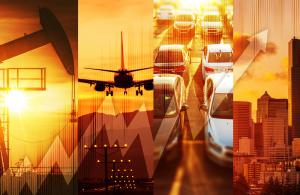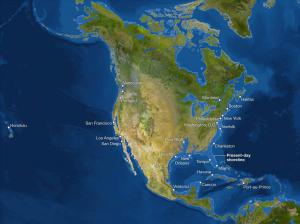
What Can Manufacturers do to Help Solve the Energy Crisis?
Global temperatures are rising and carbon-based energy resources are diminishing. Read these tips to help prevent risks and better protect our planets future!
Business is all about managing risk.
For manufacturers, a major risk looming on the horizon is the potentially devastating effect that fossil-fuel based energy (which has spurred industrial growth in developed countries for well over 100 years) is having on the world’s climate.
“But wait!” you say. Not all past predictions have come true.
We agree; that’s a valid point. History has shown many dire predictions have not come true:
In the 1970s, it was widely predicted that population growth would outstrip food production, leading to worldwide famines. While many today suffer from food shortages, the Agricultural Revolution has helped feed a hungry world that now totals over 7 billion (more than double the number of people alive in the 1970s).
King Hubbert predicted in his widely accepted “Peak Oil” theory that domestic oil and gas production would peak in 1970 and then fall into terminal decline. Thanks to the development of fracking techniques, domestic oil and gas production has returned to levels last seen in 1965.
These two developments alone have helped the world economy grow, particularly in underdeveloped regions. The emergence of China as an economic powerhouse is something that wasn’t widely anticipated before it happened. Now, other regions are poised for takeoff. Despite the 2008 financial crisis, Africa — the poorest inhabited continent — is predicted to grow at a 6% annual rate, bringing Africans to middle-income status by the year 2025.
But with this success comes new problems. We are seeing more extreme weather events, with fresh evidence that climate change is the underlying cause.
As manufacturers, we should welcome the addition of billions of new middle-class consumers across Africa, the Indian Subcontinent, South East Asia, and Latin America, but as these consumers acquire the trappings of the Western World — from gasoline and diesel powered cars to air conditioners — what risks will we incur?
Will billions of people living on the coasts be forced to abandon major cities as sea levels rise? Will Europe freeze as changing water temperatures disrupt the flow of warm Gulf Stream waters that keep its climate much warmer than its northern latitude would predict? Will expanding desert areas make arable land so scarce that food and water shortages lead to mass migration and armed conflict?
There are also risks that arise from compounding processes. Once the permafrost melts, will the release of billions of pounds of trapped carbon dioxide accelerate climate change to unimaginable levels, e.g. beyond the capacity for human life? Will we suffer from total environmental collapse as animal and plant populations suffer massive die-offs due to the spread of tropical diseases and temperature increases that exceed their ability to adapt or migrate?
What Does the Future Look Like for Manufacturers in 2050 If We Don’t Take Action Today, Such As Adopting Green Energy Solutions Based on Renewable Sources?
This all sounds pretty dire.
Hopefully, these predictions won’t come true — but managing risk means identifying potential issues and finding ways to mitigate problems.
First, let’s be specific about what the risks are for manufacturing companies between now and the year 2050:
1. Risk Lies in the Global Supply Chain Says McKinsey
Management consultant McKinsey advises manufacturers that climate-change risks extend up and down the supply chain: you can’t limit risk planning to your own immediate facility — your entire value chain (which may extend worldwide) is potentially affected.
McKinsey reports that Transport/Logistic and Agriculture, followed by Utilities and Oil and Gas will be most affected by physical risks due to climate change. Risks due to price changes will affect Utilities and Transport/Logistics most, followed by Agriculture.
2. Rising Impact of Longer Droughts, Increased Water Scarcity, Food Insecurity, and Wildfire Risk
Climate-change-driven drought is already negatively affecting food and beverage production in Australia. Droughts affecting cotton production are affecting clothing production for sporting goods manufacturer Nike.
Beverage production by multinationals has moved away from Australia to persistent water shortages. Beverage maker Coke is finding that climate change is also disrupting the supply of sugar cane, sugar beets, and citrus for fruit juice.
Widespread disruptive fires in Australia and the Western US have been joined by fires in unexpected places, such as the Smokey Mountain region and northern Alberta, where the wildfire in Fort McMurray disrupted oil sands extraction manufacturing processes in 2016.
3. Increasing Damage from Extreme Weather Events (Tornadoes, Hurricanes, Storms, Precipitation, Cold and Heat Waves, Smog) Will Disrupt Manufacturing Facilities
Increasing severity and frequency of weather-related disasters are putting manufacturing faculties around the world at risk.
Climate-change losses will cause insurance rates for manufacturing facilities to rise (or eliminate the possibility of getting coverage at all).
Air travel will be disrupted by increased atmospheric turbulence.
Higher temperatures and use of fossil fuels in mega-cities across the developing world will increase the number of disruptive ‘smog events.’
While increased temperatures may open new sea-based shipping lanes in the Arctic, the increased number of icebergs will disrupt shipping lanes.
4. Abandonment of Coastal Areas Due to Sea Level Rise and Increased Flooding Risk
In what may be the most disruptive and economically expensive consequence of climate change overall, most of the world’s port city population centers may have to retreat inland as sea levels rise this century.
Nearly all coastal areas, ranging from New York to Miami, China’s Shanghai region, Bangladesh, London, and The Netherlands will be affected.
Portions of low-lying countries, such as Bangladesh and The Maldives may have to be abandoned.
Already, global manufacturers, such as Nike, report that significant flooding in Southeast Asia is affecting their manufacturing operations.
5. Collapse of Plant, Animal and Human Eco-Systems
As humans, we are at the top of the food chain. But what happens when the food chain underneath us collapses?
Researcher Bret Scheffers, with the University of Florida, reports in the journal Science that nearly 50% of land animals and 23% of birds have suffered from climate change with effects ranging from reptiles living at higher temperatures producing only female offspring to many animals becoming smaller in size to cope with climate change.
The world’s coral reefs are becoming irreparably damaged due to the increased water temperatures, which causes corals to turn white in a process known as ‘bleaching.’ Additionally, as the oceans absorb excess carbon dioxide produced by industrialization, the world’s ocean water is becoming more acidic. This inhibits the ability of crustaceans and coral reefs to retain the calcium carbonate needed for growth.
There are limits to how hot the climate can reach before it becomes uninhabitable for humans, based on our ability to sweat enough to cool down. For example, humans have trouble surviving temperatures over 115F at 50% percent humidity. Areas, such as parts of the Middle East, are already at risk for approaching this threshold; higher temperatures would mean abandoning these areas as temperatures rise.
6. Wide-Spread Economic Disruption in World Markets for Manufactured Goods
Wars have been declared over lesser conflicts than those which may arise from climate change.
Manufacturers must plan for many eventualities, but the risk from armed conflict and mass migration due to climate change is increasingly plausible.
What Renewable Resources and Green Energy Alternatives Can Manufacturers Adopt in Order to Increase Conservation of Energy Derived from Fossil Fuels?
Read more ... https://formaspace.com/articles/manufacturing/help-solve-the-energy-crisis/?utm_source=einpresswire&utm_medium=content&utm_campaign=article-041117
Brooke Turner
Formaspace
8002511505
email us here
EIN Presswire does not exercise editorial control over third-party content provided, uploaded, published, or distributed by users of EIN Presswire. We are a distributor, not a publisher, of 3rd party content. Such content may contain the views, opinions, statements, offers, and other material of the respective users, suppliers, participants, or authors.




